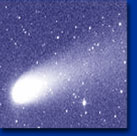Rendezvous
with a
Comet
Mission Overview
Post-Mission Activities
Assessment
Mission Overview
In the not-too-distant future a team of scientists is routinely using small, maneuverable space stations to venture out into Earth's "neighborhood" as part of a long-term study of lesser bodies in the solar system. Primary targets include comets and asteroids which scientists believe are the oldest, most primitive bodies in the solar system. It is thought that they preserve the earliest record of the material that formed Earth and its planetary neighbors.
Comet Encke |
During this mission, you and your team will work as scientists and engineers headed to rendezvous with a comet as part of the continuing study of our solar system. This rendezvous mission is critical in helping scientists confirm and better understand data collected by earlier small-body missions occurring at the start of the new millennium. In your Rendezvous with a Comet mission, Space Station astronauts working with their counterparts in Mission Control, are tasked with sending a probe to intercept and collect new data on a well-studied short-period comet known by the name Encke. Comet Encke provides an excellent target because its short orbital period (3.3 years) allows it to be observed from Earth more frequently than any other comet, including the famous Comet Halley. |
Comet Encke continues to puzzle scientists because even though it has been in a short-period orbit for thousands of years, the comet continues to demonstrate a high level of activity. Your will be the first probe to rendezvous with Comet Encke since 2003 when the comet-chasing CONTOUR spacecraft flew by it.
The small, maneuverable space station you will use for your mission requires lots of maintenance and care, providing plenty of challenges for the crews in space and on the ground. Navigating Space Station into the correct position for probe launches -- not to mention sending a probe through the material surrounding an active comet -- also requires concentrated teamwork to successfully collect vital scientific information and complete the mission. Comets are highly unpredictable objects and have been known to surprise scientists from time to time, so all crew members will need to be on their toes and ready to make quick decisions.
 |
Support for program number HST-ED-90285.01-A was provided by NASA through a grant from the Space Telescope Science Institute, which is operated by the Association of Universities for Research in Astronomy, Incorporated, under NASA contract NAS5-26555. Copyright (c) 2007 Challenger Learning Center at Prairie Aviation Museum and Challenger Learning Center of Northwest Indiana. Staff of Challenger Learning Centers and instructors of classes involved with Challenger Learning Center missions may reproduce this WebQuest guide for classroom and educational purposes. Otherwise this work may not be reproduced, stored in a retrieval system, or transcribed, in any form or by means – electronic, mechanical, photocopying, recording, or otherwise – without the prior written permission of the copyright owners. This page is based upon the WebQuest model. |
